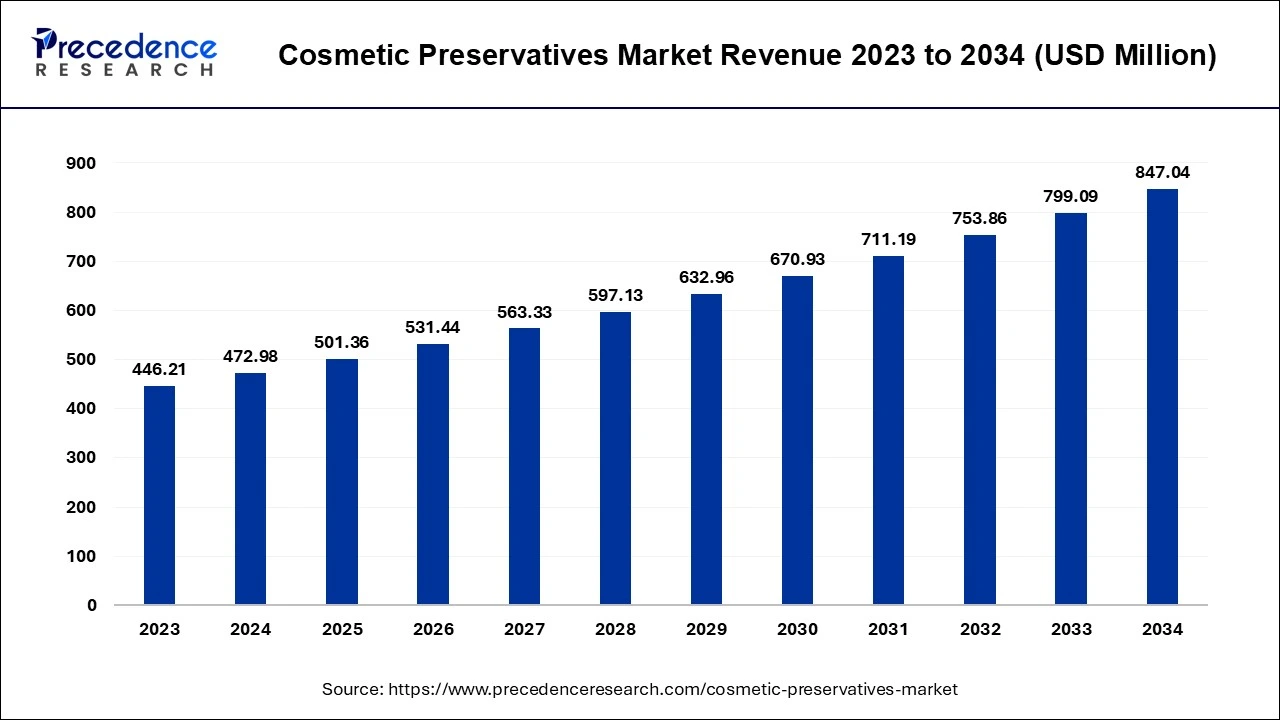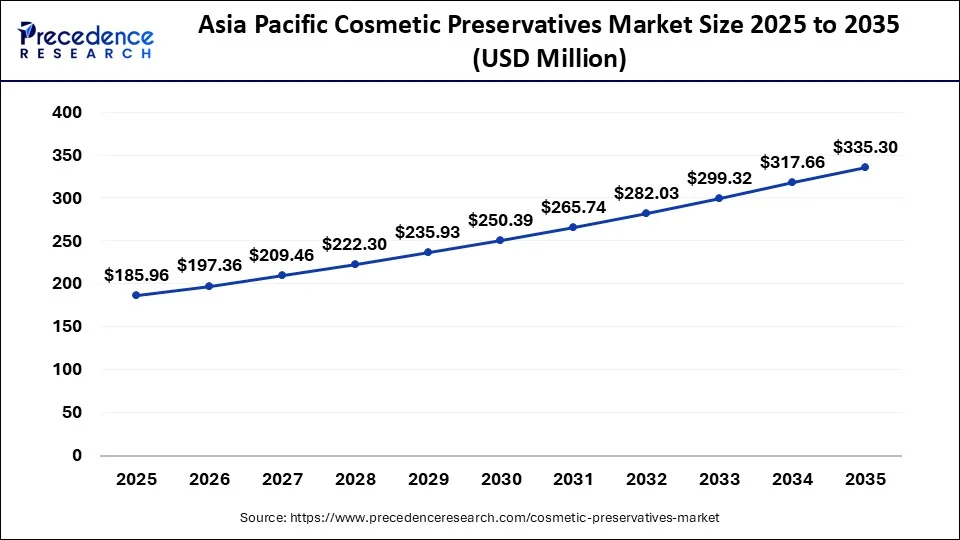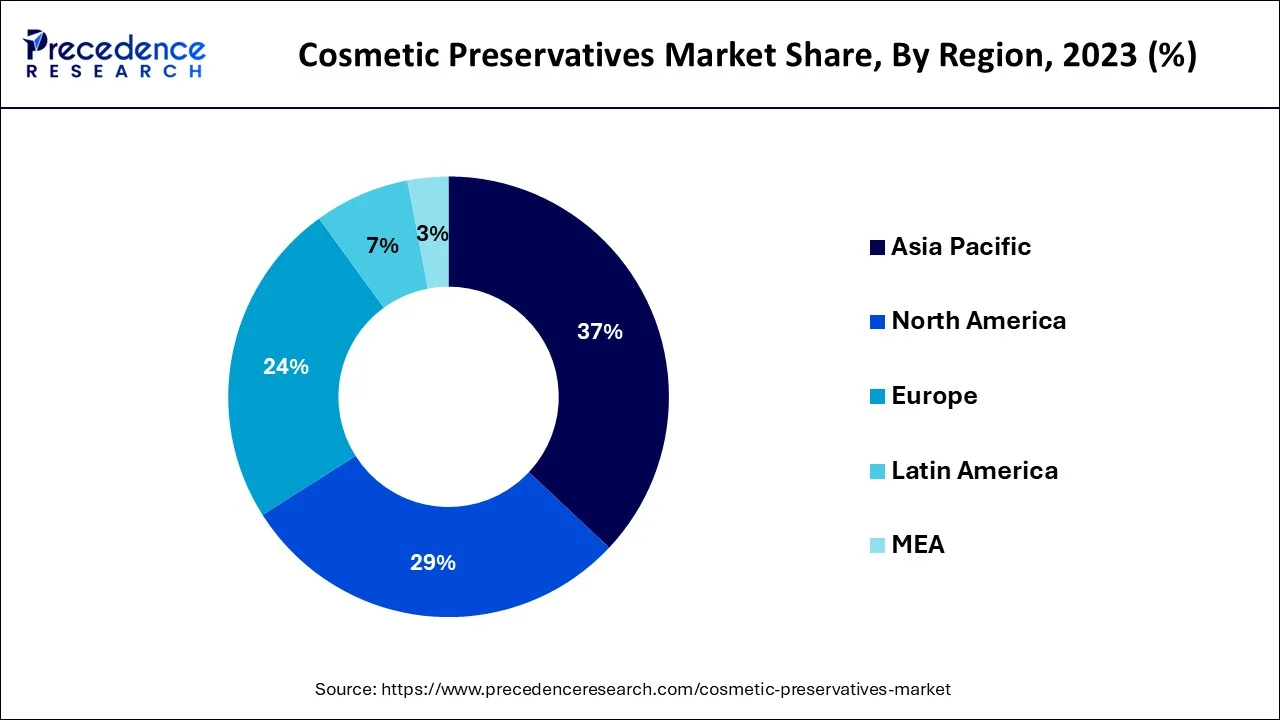List of Contents
What is the Cosmetic Preservatives Market Size?
The global cosmetic preservatives market size is calculated at USD 501.36 million in 2025 and is predicted to increase from USD 531.44 million in 2026 to approximately USD 893.18 million by 2035, expanding at a CAGR of 5.94% from 2026 to 2035.

Cosmetic Preservatives Market Key Takeaways
- In 2025, The Asia-Pacific region has held a market share of more than 37%.
- By product, the phenol derivatives segment is projected to have the largest market share from 2026 to 2035.
- By application, the conditioners & shampoos segment is projected to have the largest market share from 2026 to 2035.
- The Europe market might see positive growth during the forecast period 2026 to 2035.
Market Overview
A synthetic or natural component called a cosmetic preservative is added to personal care products to prevent unneeded chemical changes and deterioration brought on by microbial development. Preservatives are an ingredient in many cosmetic goods, including hair smoothing treatments, color cosmetics, scents, lipsticks, shampoos, conditioners, lotions, and anti-aging products. The rising cost of personal care products is what primarily drives the global market for cosmetic preservatives. Advanced preservatives have been included as a result of the rising demand for multipurpose and high-end cosmetics, supporting the expansion of the cosmetic preservatives market. Cosmetic Preservatives are becoming more popular and consumers are becoming more aware of them, which might increase product demand. The accessibility of both natural and artificial preservatives encourages the expansion of the sector.
Cosmetic Preservatives Market Growth Factors
The key drivers of the continued growth of the market for cosmetic preservatives include urbanization in developing economies and an increase in the number of working women in nations like China, India, and Korea. The variables that contribute to the advancement of society and urbanites' desire for an affluent lifestyle are crucial to the market's expansion.
- The growing end-user demand.
- Rising disposable income.
- Rising expenditure on personal grooming products
Market Scope
| Report Coverage | Details |
| Market Size in 2025 | USD 501.36 Million |
| Market Size in 2026 | USD 531.44 Million |
| Market Size by 2035 | USD 893.18 Million |
| Growth Rate from 2026 to 2035 | CAGR of 5.94% |
| Base Year | 2025 |
| Forecast Period | 2026 to 2035 |
| Segments Covered |
|
| Regions Covered |
|
Market Dynamics
Key Market Drivers
Strict legal requirements to restrict the use of ingredients
- Cosmetic products contain a range of different ingredients. This group includes cleaning chemicals, distinguishing scents, and preservatives for cosmetics. Regulatory organizations continuously take action to limit the use of substances that are harmful to human health. Strict government rules and regulations prohibit the use of natural cosmetic preservatives in the manufacture of cosmetic products, which is expected to drive the market for cosmetic preservatives to greater growth rates. Additionally, the rise in the usage of herbal compounds in cosmetic products, advancements in shelf life, and accessibility to both natural and synthetic preservatives are some of the major factors projected to fuel the growth of the cosmetic preservatives market throughout the forecast period.
Increase in the female working population
- In workforces across the world, there is a rise in female involvement. In 2021, 36% of women worldwide who were employed in organized industries were based in India, according to a report. 66.2% of the population in 2020 was made up of working women, according to a report by the European Union Commission. The percentage of women who were employed in the US in 2020 was around 56.2%, according to the Bureau of Labor Statistics. Women are now more likely than ever to be employed, which gives them more financial freedom and autonomy. The majority of cosmetics users worldwide are women. The use of skincare and cosmetics is therefore anticipated to rise as a result of financial independence, which will also result in a rise in the use of cosmetic preservatives.
Increase in purchasing of consumers
- Consumers' quality of life has increased over the past several years, increasing the population's spending capacity and, as a result, their demand for high-end cosmetics and natural personal care products. The business of cosmetic preservatives is anticipated to expand more quickly as a result of this. Global technological advancements and the rise of urbanization have made it possible for people to easily access international brands. The average person's spending power has multiplied due to economic growth and the emergence of new purchasing techniques that have supplanted conventional ones.
Key Market Challenges
The risk associated with synthetic ingredients
- The use of synthetic cosmetic preservatives in the creation of cosmetic goods is linked to a number of negative effects. For instance, prolonged usage of hydroquinone harms one's health since it irritates the respiratory system, produces skin cancer, and is toxic to the organ systems. Mercury can harm the brain, kidneys, and liver, yet it can also brighten skin tone and reduce black spots when used extensively as a cosmetic.
Key Market Opportunities
Male-specific cosmetics are receiving more attention
- Nowadays, people are more inclined to utilize cosmetics to make themselves seem better. Moisturizers, anti-aging creams, and mud masks made specifically for men are in great demand. Younger men deal with a variety of problems, such as hair loss, oily skin, acne, and wrinkles. All of these problems may be overcome with the use of appropriate, natural cosmetic preservatives and knowledge on how to employ the proper cosmetic preservatives. As a result, there is significant room for growth for cosmetic preservatives that specifically target the male market.
Segment Insights
Product Insights
On the basis of product, the phenol derivatives segment is expected to have the largest market share in the coming years period, this segment has dominated the market in the past with the maximum share in terms of revenue and it will continue to grow well in the coming years.
The category for phenol derivatives is anticipated to see the greatest CAGR throughout the forecast period. The increasing usage of phenol derivatives, notably phenoxyethanol, in the manufacture of cosmetics including skin-lightening creams and lotions, hair coloring solutions, and sunscreens is one of the aspects that may be credited to the segment's rise. Since many years ago, phenol derivatives have been utilized in cosmetic goods and are efficient against a variety of microorganisms.
Application Insights
On the basis of application, the conditioners & shampoos segment is expected to have the largest market share in the coming years period, the segment has dominated the market and it will continue to grow well in terms of revenue. It is advised to employ either natural or synthetic preservatives in the formulation of shampoos and conditioners due to their high water and oxygen content. The market for cosmetic preservatives is being driven by the growing popularity of organic and natural shampoos and conditioners, which is why this market segment is growing.
The facemasks, sunscreens, scrubs & lotions are expected to grow at a significant rate during the forecast period. This application category is expected to develop as people become more aware of the damage that ultraviolet rays do to the skin. Due to increased public knowledge of the effects and harm that the sun may do to exposed skin, sunscreen use is on the rise. The part highlights benefits, such as the fact that sunscreen products' main objective is to prevent or reduce skin damage caused by UV and solar radiation. Skin cancer and actinic aging are two examples of these impacts. Moisturization and a decrease in UV-induced melanin production on exposed skin are secondary advantages. Today's sun care formulator must create solutions that are both elegantly designed to encourage consumer compliance and cost-effectively designed to be accessible in challenging economic times, all while meeting strict SPF and UVA protection criteria.
Regional Insights
Asia Pacific Cosmetic Preservatives Market Size and Growth 2026 to 2035
The Asia Pacific cosmetic preservatives market size is estimated at USD 185.69 million in 2025 and is expected to be worth around USD 335.30 million by 2035, rising at a CAGR of 6.07% from 2026 to 2035.

On the basis of geography, Asia-Pacific has held a market share of more than 37% in 2023, the Asia Pacific market was the industry leader in terms of cosmetic preservatives. Growing consumer demand for cosmetics and rising public awareness of personal hygiene and cleanliness are anticipated to drive market expansion in this area. According to projections, China and India will expand rapidly, followed by other South East Asian nations. The growing popularity of Gen X and millennial customers in China, Japan, and India has led to an increase in the market for cosmetic preservatives. Additionally, a lot of cosmetic businesses are adopting high-end chemicals for cosmetic preservation, which is predicted to boost market share. As living standards and views regarding the dermatological aspect of skincare evolve, there will likely be an increase in demand for premium cosmetic components. The aging of the population, the trend toward luxury cosmetics, and the rapid development in demand for high-quality products are all expected to have a significant impact on market share.

What Potentiates the Growth of the Cosmetic Preservatives Market in Europe?
Up to 2033, the Europe market might see positive growth. Europe is anticipated to have the second-largest market share. Europe's market is fueled by nations like Germany, the UK, France, Italy, and Spain. Due to the rising production of high-end beauty items, Germany is predicted to expand at the greatest CAGR throughout the projection period.
The market within Europe is expected to grow at a notable rate over the forecast period, driven by strict compliance with the EU Cosmetics Regulation. The region demonstrates strong demand for eco-certified, biodegradable, and low-toxicity preservatives, particularly in natural and organic cosmetics. Innovation is centered around multifunctional ingredients that provide both preservation and skin-benefit properties, supporting the development of premium products across skincare and personal care categories.
Germany plays a vital role in the European cosmetic preservatives market, backed by a robust cosmetics manufacturing sector and leadership in natural and organic beauty products. German consumers are highly conscious of ingredient safety, boosting demand for preservative systems that meet EU ecolabels and dermatological standards. The country's advanced chemical industry and emphasis on sustainable formulation practices further drive innovation and the adoption of next-generation preservatives.
What Opportunities Exist in North America?
North America presents significant opportunities for the cosmetic preservatives market, supported by high consumption of personal care products and strong demand for clean-label and multifunctional formulations. The region emphasizes safety, efficacy, and regulatory compliance, promoting the use of alternative and naturally derived preservatives. The increasing demand for high-quality cosmetics, dermatologically tested products, and long-lasting formulations continues to drive market growth.
The U.S. is a major contributor to the North American market, driven by stringent FDA regulatory oversight and increasing consumer awareness of ingredient transparency and skin sensitivity. Manufacturers are actively shifting away from controversial preservatives toward paraben- and formaldehyde-free, organic alternatives. Rising demand for anti-aging, skincare, and cosmeceutical products, combined with a strong presence of global cosmetic brands, supports consistent demand for advanced preservation systems.
Cosmetic Preservatives Market - Value Chain Analysis
- Chemical Synthesis & Formulation
Cosmetic preservatives are developed through organic chemical synthesis, bio-based fermentation, purification, blending, and formulation to prevent microbial growth in personal care products. These include parabens, organic acids, alcohols, phenoxyethanol, and emerging natural preservatives.
Key Players: BASF SE, Clariant AG, Ashland Global Holdings, and Lonza Group. - Quality Testing & Certification
Cosmetic preservatives require certifications for antimicrobial efficacy, toxicological safety, skin compatibility, and regulatory compliance. Key certifications include ISO 22716 (Cosmetic GMP), EU Cosmetics Regulation (EC No. 1223/2009), FDA cosmetic compliance, and microbial challenge testing standards.
Key Players: ISO (International Organization for Standardization), FDA (U.S. Food and Drug Administration), European Commission, UL Solutions. - Distribution to End-Use Industries
Cosmetic preservatives are supplied to manufacturers of skincare, haircare, makeup, toiletries, and personal hygiene products through specialty chemical distributors and direct formulation partnerships.
Key Players: Croda International, DSM-Firmenich, Evonik Industries.
Cosmetic Preservatives Market Companies
- Ashland
- International Flavors and Fragrances Inc.
- Clariant AG
- Salicylates and Chemicals Pvt. Ltd
- Sharon Laboratories
- Dow
- The Lubrizol Corporation
- NIPPON SHOKUBAI CO. LTD
- BASF SE
- Evonik Industries
- Akema
- Symrise AG
- Chemipol
- Henan Qingshuiyuan Technology CO., Ltd.,
Recent Developments
In February 2022– To develop its personalized personal care product technology, BASF is heavily reinvesting in its strategic partner B2B Cosmetics. The Engage system, which offers consumers freshly manufactured, customized cosmetics, has continued to be developed by BASF and B2B Cosmetics. Users may create custom personal care items using Image technology.
Segments Covered in the Report
By Product
- Formaldehyde Donors
- Inorganics
- Paraben Esters
- Alcohols
- Phenol Derivatives
- Quaternary Compounds
- Organic Salts
- Others
By Application
- Conditioners & Shampoos
- Facemasks, Sunscreens, Scrubs & Lotions
- Shower Cleansers, Soaps and Shaving Gels
- Powder Compacts and Face Powder
- Toothpaste and Mouthwash
- Others
By Raw Material
- Synthetic
- Natural
By Geography
- North America
- Europe
- Asia-Pacific
- Latin America
- Middle East & Africa (MEA)
For inquiries regarding discounts, bulk purchases, or customization requests, please contact us at sales@precedenceresearch.com
Frequently Asked Questions
Ask For Sample
No cookie-cutter, only authentic analysis – take the 1st step to become a Precedence Research client



